The Physics of Free Will – Overview
Chapter 1 discusses the reasons we cannot deny free will. After accepting free will as real, we set out to integrate free will into physics. This process will reveal the amino acid as the elementary structure of consciousness.
In more detail, Chapters 2 and 3 reexamine the starting assumptions of science and modify them as needed to remove any implicit barriers to free will. New vocabulary will be introduced to clarify the important concepts needed for integrating free will and physics.
Chapter 4 covers how thoughts that have no momentum can exert forces on atoms to change their motion, but without violating the conservation laws. Chapter 6 covers free will and the second law of thermodynamics.
Chapters 8 and 9 zero in on the amino acid as the one and only structure throughout the universe that can take on a conscious state. They also cover how conscious amino acids direct evolution, control protein folding, and how they function as conscious neurotransmitters.
We now seek the origin of consciousness, how does the amino acid take on a conscious state?
Physics has found that all matter behaves statistically at the quantum level. However, Chapter 1 covers why free will choices cannot have a statistical basis. This means that we will have to reject the physical laws as the cause of consciousness in matter.
We will then work out the complete set of god constraints that must be met for any god solution to be scientifically acceptable. These formidable god constraints will be our guide for resolving the consciousness origin problem.
By the end, it will be possible for science to fulfill its mission without any limitations in a universe where matter can become conscious and act freely on its surroundings.
The Author

Wayne Portwine is board certified in Medical Physics by the American Board of Radiology. He has been working as a Medical Physicist for 29 years. He earned a Master’s Degree in Physics at Florida State in 1994.
Book Cover

Read the Book
If you came to this page from another chapter, use the browser back button to return to your chapter.